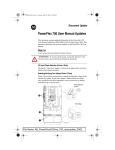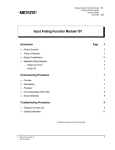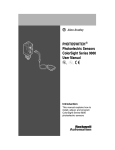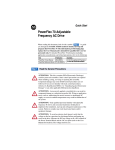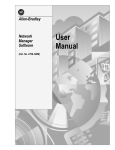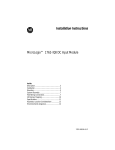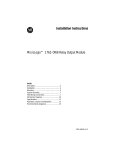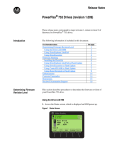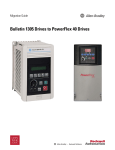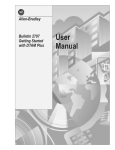Download User Manual Documentation Update
Transcript
Document Update PowerFlex 70 User Manual Additions and Corrections Reference PowerFlex 70 User Manual, Publication 20A-UM001A-EN-P – August 2000. New General Precautions ! ! ! ATTENTION: Risk of injury or equipment damage exists. DPI or SCANport host products must not be directly connected together via 1202 cables. Unpredictable behavior can result if two or more devices are connected in this manner. ATTENTION: A risk of injury or equipment damage exists in firmware version 1.011 and earlier. When there is a combination of long shielded motor cables, high source impedance, low speed, light motor load and parameter 190 [Direction Mode] is set to “Unipolar” or “Bipolar,” an unexpected change in motor direction may occur. If these conditions exist, choose one of the following corrective actions: • Set parameter 190 to “Reverse Dis” • Set parameters 161 and 162 to “Disabled” • Install a properly sized Dynamic Brake resistor ATTENTION: Nuisance tripping may occur in firmware version 1.011 and earlier due to unstable currents. When using a motor that is connected for a voltage that is different from the drive (e.g., using a 230V connected motor with a 460V drive) the following adjustment must be made to “Stability Gain” using DriveExplorer software and a personal computer. Motor Nameplate Voltage --------------------------------------------------------------- × 128 Drive Rated Voltage Any adjustment made to “Stability Gain” must be manually restored if the drive is reset to defaults or is replaced. If unstable currents are still present after making the adjustment, contact the factory for assistance. 2 ! ATTENTION: The “adjust freq” portion of the bus regulator function is extremely useful for preventing nuisance overvoltage faults resulting from aggressive decelerations, overhauling loads, and eccentric loads. It forces the output frequency to be greater than commanded frequency while the drive's bus voltage is increasing towards levels that would otherwise cause a fault; however, it can also cause either of the following two conditions to occur. 1. Fast positive changes in input voltage (more than a 10% increase within 6 minutes) can cause uncommanded positive speed changes; however an “OverSpeed Limit” fault will occur if the speed reaches [Max Speed] + [Overspeed Limit]. If this condition is unacceptable, action should be taken to 1) limit supply voltages within the specification of the drive and, 2) limit fast positive input voltage changes to less than 10%. Without taking such actions, if this operation is unacceptable, the “adjust freq” portion of the bus regulator function must be disabled (see parameters 161 and 162). 2. Actual deceleration times can be longer than commanded deceleration times; however, a “Decel Inhibit” fault is generated if the drive stops decelerating altogether. If this condition is unacceptable, the “adjust freq” portion of the bus regulator must be disabled (see parameters 161 and 162). In addition, installing a properly sized dynamic brake resistor will provide equal or better performance in most cases. Note: These faults are not instantaneous and have shown test results that take between 2 and 12 seconds to occur. 3 Revised Attention Statement Refer to page 1-9 ! ATTENTION: A contactor or other device that routinely disconnects and reapplies the AC line to the drive to start and stop the motor can cause drive hardware damage. The drive is designed to use control input signals that will start and stop the motor. If an input device is used occasionally, an auxiliary contact on that device should also be wired to a digital input programmed as an “Enable” function. The input device must not exceed one operation per minute or drive damage will occur. Bipolar Wiring Diagram Replaces the diagram on page 1-13. Input/Output Analog Voltage Input - Bipolar(1) ±10V Input 100 ohm input impedance Connection Example(2) Standard Bipolar Joystick Bipolar 18 18 19 361 to 366 19 or 22 -10V Com +10V Power Source (1) (2) Refer to the Attention statement on page 1-9 for important bipolar wiring information. Examples are based on factory default parameter settings. Refer to previous page for parameters that are related to the individual inputs/outputs. Start Up Menu Replaces diagram on page 2-3. Main Menu: Start-Up Input Voltage Motor Data and Ramp Times Motor Tests Speed Limits Configure for Alternate Input Voltage Enter Motor NP Data, Stop Mode, Accel/Decel Ramp Times Optimize Torque and Verify Direction Set Min/Max Speed and Direction Control Speed Control Start/Stop/I/O Configure Configure Source, Value Control Method and Scale for (2 Wire/3 Wire), I/O, Speed References Digital Inputs/Outputs and Analog Outputs Done / Exit 4 New Important Notes About Parameter Groups No. Parameter Name and Description Related Group Slip Comp File C Refer to page 3-15. Values Important: Parameters in the Slip Comp Group are used to enable and tune the Slip Compensation Regulator. In order to allow the Slip Compensation Regulator to control drive operation, parameter 080 [Speed Mode] must be set to 1 “Slip Comp”. No. Parameter Name and Description Related Group Process PI File C Refer to page 3-15. Values Important: Parameters in the Process PI Group are used to enable and tune the PI Loop. In order to allow the PI Loop to control drive operation, parameter 080 [Speed Mode] must be set to 2 “Process PI”. Corrections To Parameters No. Parameter Name and Description 002 [Commanded Freq] Value of the active frequency command. Values Default: Related Group File A Refer to page 3-8. Read Only Min/Max: –/+[Maximum Speed] Display: 0.1 Hz No. Parameter Name and Description 016 [Analog In1 Value] 017 [Analog In2 Value] Value of the signal at the analog inputs. Values Default: Related Group File A Refer to page 3-8. Read Only Min/Max: 4.000/20.000 mA –/+10.000V Display: 0.001 mA or 0.001 Volt 5 No. Parameter Name and Description 045 [Motor NP Power] Set to the motor nameplate rated power. 32 Values Default: Related Group File B Refer to page 3-9. Based on Drive Type 046 Min/Max: 0.0/100.0 Display: See [Mtr NP Pwr Units] No. Parameter Name and Description 047 [Motor OL Hertz] Values Default: Related Group File B Refer to page 3-10. Motor NP Hz/3 Selects the output frequency below which Min/Max: 0.0/Motor NP Hz the motor operating current is derated. Display: 0.1 Hz The motor thermal overload will generate a fault at lower levels of current. 042 220 No. Parameter Name and Description 055 [Maximum Freq] Values Default: Related Group File B Refer to page 3-10. 110.0 or 130.0 Hz 083 Sets the highest frequency the drive will Min/Max: 5.0/400.0 Hz output. Display: 0.1 Hz Refer to parameter 083 [Overspeed Limit]. Related No. Parameter Name and Description Values 056 [Compensation] Enables/disables correction options. En a Re ble J flec erk tW ave Group File B Refer to page 3-10. x x x x x x x x x x x x x x 1 1 15 14 13 12 11 10 9 8 7 6 5 4 3 2 1 0 Nibble 4 Nibble 3 Nibble 2 Nibble 1 Bit # Factory Default Bit Values 1 =Enabled 0 =Disabled x =Reserved 6 No. Parameter Name and Description DYNAMIC CONTROL (File D) Stop/Brake Modes 158 [DC Brake Level] Values Default: Related Group File D Refer to page 3-18. [Rated Amps] Defines the maximum DC brake current in Min/Max: 0/[Rated Amps] × 1.5 percentage of drive rated current. (Equation yields approximate maximum The DC braking voltage used in this value.) function is created by a PWM algorithm and may not generate the smooth holding Display: 0.1 Amps force needed for some applications. Refer to the PowerFlex Reference Manual. ! ATTENTION: If a hazard of injury due to movement of equipment or material exists, an auxiliary mechanical braking device must be used to stop the motor. ! ATTENTION: This feature should not be used with synchronous or permanent magnet motors. Motors may be demagnetized during braking. No. Parameter Name and Description 163 [DB Resistor Type] Selects whether the internal or an external DB resistor will be used. Values Default: Options: Related File D Stop/Brake Modes Group Refer to page 3-19. 0 “Internal Res” 0 1 2 “Internal Res” “External Res” “None” 161 162 7 No. Parameter Name and Description Related Group File E Refer to page 3-23. Values 211 [Drive Alarm 1] 212 De c Drv el Inh i Drv OL L bt OL vl 2 Lvl 1 Int DB An Re lg s Str in L OH A o Po t Pw ss we rU Un r Lo p d s Pre erVo s chr ltag gA e ctv Diagnostics UTILITY (File E) Alarm conditions that currently exist in the drive. x x x x x x 0 0 0 x 0 0 0 0 0 0 15 14 13 12 11 10 9 8 7 6 5 4 3 2 1 0 Nibble 4 Nibble 3 Nibble 2 Nibble 1 Bit # 1 =Condition True 0 =Condition False x =Reserved No. Parameter Name and Description Related Group File E Refer to page 3-27. Values 238 [Fault Config 1] De c Au el Inh tR i Sh st T bt e ri Mo ar Pi es tor n Ov erL Un d de Po rVo we ltag rL e oss UTILITY (File E) Faults Enables/disables annunciation of the listed faults. x x x x x x x x x 1 0 0 1 x 1 0 15 14 13 12 11 10 9 8 7 6 5 4 3 2 1 0 Nibble 4 Nibble 3 Nibble 2 Nibble 1 Bit # Factory Default Bit Values 1 =Enabled 0 =Disabled x =Reserved No. Parameter Name and Description Related Group File E Refer to page 3-28. Values 259 [Alarm Config 1] De c Drv el Inh i Drv OL L bt OL vl 2 Lvl 1 Int D An BRe lg i s O Str n L H A o Po t Pw ss w r Un er Lo Up d s Pre erVo s chr ltag gA e ctv Alarms UTILITY (File E) Enables/disables alarm conditions that will initiate an active drive alarm. x x x x x x 1 1 1 x 1 1 1 1 1 1 15 14 13 12 11 10 9 8 7 6 5 4 3 2 1 0 Nibble 4 Nibble 3 Nibble 2 Nibble 1 Bit # Factory Default Bit Values 1 =Enabled 0 =Disabled x =Reserved 8 No. Parameter Name and Description 342 [Analog Out1 Sel] Values Default: Options: Analog Outputs INPUTS & OUTPUTS (File J) Selects the source of the value that drives Options: the analog output. 0 1 2 3 4 5 6 7 8 9 10 11 12 13 “Output Freq” “Commanded Freq” “Output Amps” “Torque Amps” “Flux Amps” “Output Power” “Output Volts” “DC Bus Volts” “PI Reference” “PI Feedback” “PI Error” “PI Output” “%Motor OL” “%Drive OL” Related Group File J Refer to page 3-34. 0 “Output Freq” See Table [Analog Out1 Lo] Value [Analog Out1 Hi] Value [Analog Out Absolut] = Disabled [Analog Out Absolut] = Enabled –[Maximum Freq] –[Maximum Speed] 0 Amps –200% Rated 0 Amps 0 kW 0 Volts 0 Volts –100% –100% –100% –100% 0% 0% 0 Hz 0 Hz 0 Amps 0 Amps 0 Amps 0 kW 0 Volts 0 Volts 0% 0% 0% 0% 0% 0% +[Maximum Freq] +[Maximum Speed] 200% Rated 200% Rated 200% Rated 200% Rated 120% Rated 200% Rated 100% 100% 100% 100% 100% 100% 001 002 003 004 005 007 006 012 135 136 137 138 220 219 No. Parameter Name and Description 343 [Analog Out1 Hi] Sets the analog output value when the source value is at maximum. 344 [Analog Out1 Lo] Sets the analog output value when the source value is at minimum. Values Default: Related Group File J Refer to page 3-34. 10.0 Volt Min/Max: 0.0/10.0 Volts Display: 0.1 Volt Default: 0.0 Volt 342 342 Min/Max: 0.0/10.0 Volts Display: 0.1 Volt No. Parameter Name and Description 363 [Digital In3 Sel] Selects the function for the digital inputs. Values Default: Related Group File J Refer to page 3-35. 18 “Auto/ Manual” 9 No. Parameter Name and Description 381 [Dig Out1 Level] 385 [Dig Out2 Level] Sets the relay activation level for options 10 – 15 in [Digital Outx Sel]. Units are assumed to match the above selection (i.e. “At Freq” = Hz, “At Torque” = Amps). Values Default: Related Group File J Refer to page 3-36. 0.0 0.0 380 Min/Max: 0.0/819.2 Display: 0.1 Correction To Fault Action Fault Analog In Loss No. 29 Type(1) Refer to page 4-4. ➀ ➂ ➁ Anlg Cal Chksum 108 (1) Description An analog input is configured to fault on signal loss. A signal loss has occurred. Configure with [Anlg In 1, 2 Loss] on page 3-33. The checksum read from the analog calibration data does not match the checksum calculated. Action 1. Check parameters. 2. Check for broken/loose connections at inputs. Replace drive. See page 4-1 for a description of fault types. Fault Decel Inhibit (1) No. 24 Type(1) New Fault ➂ Description The drive is not following a commanded deceleration because it is attempting to limit bus voltage. See page 4-1 for a description of fault types. Action 1. Verify input voltage is within drive specified limits. 2. Verify system ground impedance follows proper grounding techniques. 3. Disable bus regulation and/or add dynamic brake resistor and/ or extend deceleration time. 10 Renumbered Testpoint Codes and Functions Refer to page 4-10. Code Selected in [Testpoint x Sel] 1 2 3 4 5 6 7 8 9 10 11-99 Function Whose Value is Displayed in [Testpoint x Data] DPI Error Status Heatsink Temperature Active Current Limit Active PWM Frequency Lifetime MegaWatt Hours Lifetime Run Time Lifetime Powered Up Time Lifetime Power Cycles Life MegaWatt Fraction Life MegaWatt Fraction Units Reserved for Factory Use 11 Notes: 12 To contact Drives Technical Support . . . Tel: (1) 262 512-8176, Fax: (1) 262 512-2222 Email: [email protected] Online: www.ab.com/support/abdrives Reach us now at www.rockwellautomation.com Wherever you need us, Rockwell Automation brings together leading brands in industrial automation including Allen-Bradley controls, Reliance Electric power transmission products, Dodge mechanical power transmission components, and Rockwell Software. Rockwell Automation's unique, flexible approach to helping customers achieve a competitive advantage is supported by thousands of authorized partners, distributors and system integrators around the world. Americas Headquarters, 1201 South Second Street, Milwaukee, WI 53201-2496, USA, Tel: (1) 414 382-2000, Fax: (1) 414 382-4444 European Headquarters SA/NV, Boulevard du Souverain 36, 1170 Brussels, Belgium, Tel: (32) 2 663 0600, Fax: (32) 2 663 0640 Asia Pacific Headquarters, 27/F Citicorp Centre, 18 Whitfield Road, Causeway Bay, Hong Kong, Tel: (852) 2887 4788, Fax: (852) 2508 1846 Publication 20A-DU001B-EN-P – March 2001 307288-Q01 Supersedes November 2000 Copyright 2001 Rockwell International Corporation. All rights reserved. Printed in USA.












